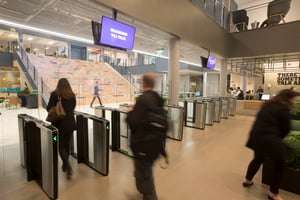You’ve just held open the front door of your office building to a well-dressed person who was fumbling for their access card. You’re feeling pleased about the good deed that you just did. Except – in reality, you just let in a hacker who will soon bypass your company’s network security and gain easy access to your organization’s most valuable electronic assets.
Forensic Versus Preventive
 Many organizations may believe that access control systems, surveillance cameras, and security guards are the best approach to securing a facility. By keeping intruders out, you can prevent crimes such as physical theft and violence, while also protecting intellectual property.
Many organizations may believe that access control systems, surveillance cameras, and security guards are the best approach to securing a facility. By keeping intruders out, you can prevent crimes such as physical theft and violence, while also protecting intellectual property.
The problem with that “forensic” approach is that by the time someone notices an intrusion on surveillance video, the crime has already happened. Security solutions such as access controls, cameras, and guards do provide a deterrent, but they won’t stop a determined attacker.
Further, after the intrusion is discovered, your security team needs to investigate the crime, and that takes time and resources – and an investigation may not always result in the criminal being caught. What’s more, many surveillance systems retain a limited time window of records – sometimes only 30 or 60 days – and undetected intrusions may well have been erased before they are even discovered.
The only way to ensure safety and security for your facility is to take a preventive approach and stop intrusions before they happen in order to avoid the potential negative outcomes, which may include theft, liability, cyber crimes, workplace violence, or even worse.
A Proactive Approach
Taking a proactive approach to securing your facility includes the installation of security entrances at your perimeter and other key access points. Security entrances can reduce or eliminate the possibility of tailgating or social engineering ploys to get around security guards, and provide a consistent and preventive barrier to mitigate all types of risk. Security entrances are designed for a range of security levels.
 For example, in a corporate lobby with security staff, optical turnstiles can be employed to allow for quick entry of authorized persons while also detecting any attempts of unauthorized personnel to sneak in. Their design allows for protection even when security guards are busy or distracted. When an attempted intrusion is detected, they raise an immediate alarm that can be handled by the nearby security staff.
For example, in a corporate lobby with security staff, optical turnstiles can be employed to allow for quick entry of authorized persons while also detecting any attempts of unauthorized personnel to sneak in. Their design allows for protection even when security guards are busy or distracted. When an attempted intrusion is detected, they raise an immediate alarm that can be handled by the nearby security staff.
A higher end solution includes security revolving doors and mantrap portals that can be deployed to prevent unauthorized entry with no security guards needed. These types of security entrances have sophisticated sensors in the ceiling to detect piggybacking or tailgating (when two people try to enter on a single authorization) and will not allow such entry. In addition, mantrap portals are ideally configured to accept a biometric authentication inside the compartment, ensuring that the person entering matches the authorized credentials presented at the outside of the portal.
Risk and Liability Management
Reducing organizational risk and ultimately, liability, is one of the most critical ways to ensuring the continuation of your organization’s people, assets and property. In the past, one of the greatest challenges to preventing infiltration was predicting how and when an intruder would attempt to enter a facility.
Consider this: what is the probability that a person could successfully tailgate through an unguarded swing door with an authorized person? Would you agree that it is a fairly high percentage, likely above 80%? What if the door had a guard watching? That percentage would go down significantly, but would it be zero percent? Probably not, due to potential distraction or possibly, social engineering tactics. Coming up with a number has always been guesswork. What if you could take the ‘human vulnerabilities’ out of the picture completely?
A New Metric
Today, new technologies make it possible to take a proactive stance to reducing the risk of a successful attempt. For example, security revolving doors and mantrap portals are “always closed” unless authorized credentials are presented. Once a person enters a Boon Edam door, the sensors in StereoVision 2® build a 3-D image of their shape and test this rendering against a set of tight parameters. This “shape” is accepted or rejected based on how these parameters are configured ahead of time.
 During the configuration process, StereoVision 2 shows you the probability (based on rigorous testing and mathematical sampling) that two people could successfully enter through the door based on the current parameter settings. This probability is expressed as a “false acceptance” percentage that approaches zero, which is saying, “With the settings you have now, there is an x% chance of successful piggybacking occurring at this door.” Thus, doors using StereoVision 2 enable you to provide a clear, ROI metric to the C-suite that demonstrates a proactive stance against intrusion.
During the configuration process, StereoVision 2 shows you the probability (based on rigorous testing and mathematical sampling) that two people could successfully enter through the door based on the current parameter settings. This probability is expressed as a “false acceptance” percentage that approaches zero, which is saying, “With the settings you have now, there is an x% chance of successful piggybacking occurring at this door.” Thus, doors using StereoVision 2 enable you to provide a clear, ROI metric to the C-suite that demonstrates a proactive stance against intrusion.
Ultimately, you can deploy security entrances as “layers” throughout a building according to their capabilities. For example, you can place full height turnstiles at the fence line to deter casual intrusion from the public, supervised optical turnstiles in the lobby to detect and respond to tailgating attempts, and further inside, unmanned security revolving doors and mantrap portals to prevent infiltration to the most sensitive areas. Building on this “structure” you can then engage people, processes and technology to supplement and work with your entrance capabilities and progressively decrease the chance of successful infiltration from the exterior to the interior. Security entrances, when deployed with such a holistic strategy, become the “backbone” of a proactive approach to securing your facility.

